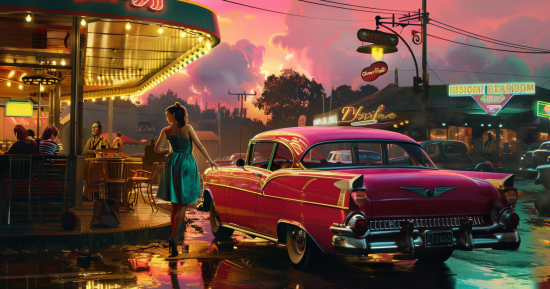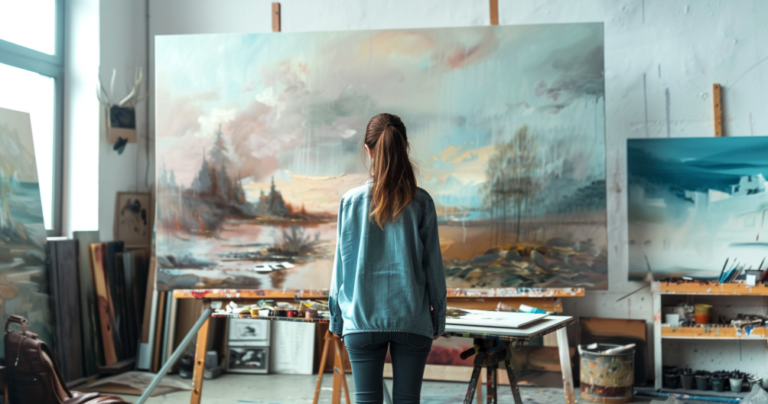Modern art, which emerged in the late 19th and early 20th centuries, distinguished itself as an artistic movement marked by a departure from tradition and an embrace of more abstract and inventive techniques in creating art. This era, stretching from the 1860s to the 1970s, witnessed artists embarking on a quest to question, redefine, and even challenge the prevailing aesthetics of their time. This led to a wide array of styles and philosophical perspectives, reflecting a notable break from historical norms.
Most Important Movements In Modern Art
Some of the major movements in modern art include Impressionism, Expressionism, Cubism, Fauvism, Dadaism, and Surrealism. These styles often shared a common goal of pushing the boundaries of what was considered acceptable or beautiful in art, and they were driven by a relentless spirit of experimentation. As a result, modern art produced an array of innovative and groundbreaking works that continue to captivate and inspire audiences to this day.
In exploring the world of modern art, it is essential to understand the historical, social, and economic contexts that contributed to its development. The Industrial Revolution, the rise of the modern city, and other major events during this time period all played a key role in shaping the ideas and techniques that artists would employ in their work. Ultimately, modern art stands as a testament to the creativity and vision of artists who dared to challenge conventions and forge a new path in the realm of visual expression.
Historical Context
Origins and Early Influences
Modern art is an art movement that emerged in the late 19th and early 20th centuries. It was characterized by a shift away from traditional styles to a more abstract, experimental approach to creating works of art. The desire to create new forms of art, philosophy, and social structures that accurately reflected the rapidly developing world influenced the development of modern art. Some of the key artists during this period, such as Claude Monet, Vincent van Gogh, and Pablo Picasso, contributed to the foundation of modern art by pioneering various techniques or styles.
Key Movements
Numerous movements occurred within the broader scope of modern art, including:
- Impressionism – Originating in France, this movement focused on capturing the fleeting, visual impression of a scene.
- Expressionism – Associated mostly with German artists, this movement sought to convey emotional experiences through art.
- Cubism – Pioneered by artists like Pablo Picasso, this movement presented multiple viewpoints of a subject simultaneously.
- Fauvism – A movement marked by the use of vibrant colors and simplified forms.
- Dadaism – A form of anti-art born out of a reaction to the horrors of World War I.
- Surrealism – This movement sought to explore the unconscious mind and the world of dreams.
Each of these movements contributed to the evolution of modern art throughout the 20th century.
Differences from Traditional Art
Modern art differed from traditional styles in several ways:
- Subject Matter: Whereas traditional art often focused on religious or historical themes, modern art embraced a wider range of subjects, including everyday scenes, abstract ideas, and the subconscious.
- Techniques and Materials: Artists began to experiment with new techniques, materials, and mediums, breaking away from conventional means of creating art.
- Styles: Instead of adhering to established styles, modern artists often developed unique and individual approaches to their work.
- Concepts: Modern art placed a greater emphasis on the idea or concept behind a work, often challenging the viewer to engage with the artwork in order to interpret its meaning.
While modern art spanned a variety of styles and movements, it was primarily centered on the idea of breaking away from traditional norms and embracing experimentation and innovation.
Characteristics of Modern Art
Styles and Techniques
Modern art emerged in the late 19th and early 20th centuries as a major shift away from traditional art styles, embracing a more abstract and experimental approach to creating works of art. Some of the most prominent modern art movements include Impressionism, Expressionism, Cubism, Fauvism, Dadaism, and Surrealism.

- Impressionism: Focused on capturing fleeting moments and the changing qualities of light, color, and atmosphere in a scene.
- Expressionism: Aimed to evoke emotions and elicit strong reactions by emphasizing the artist’s personal feelings and experiences.
- Cubism: Radically fragmented and isolated subjects into geometric shapes, breaking down space into a series of interconnecting planes.
- Fauvism: Employed bold, intense colors and strong brushwork to create vivid, sometimes almost abstract, compositions.
- Dadaism: Challenged established norms and embraced randomness, irrationality, and the absurd as a form of artistic protest against society.
- Surrealism: Delved into the world of dreams, subconscious thoughts, and the irrational, often using automatic drawing or writing techniques.
Themes and Concepts
As artists sought new ways to express themselves, the themes and concepts in their work began to shift as well. Modern art moved away from purely representational imagery and instead focused on exploring the uncharted territories of abstraction, symbolism, and imagination.
One common theme in modern art is the deconstruction of traditional forms and values in order to examine and reshape societal norms. This is evident in movements like Cubism, where familiar subjects are broken down to reveal new perspectives and challenge viewers’ expectations of what art should look like.
Another key theme is the exploration of the human psyche and emotions. Expressionism, for example, was deeply rooted in the personal experiences and feelings of the artists, resulting in works that depict intense emotions.
Finally, many modern artists were also deeply influenced by the rapidly changing world around them at the time. The Industrial Revolution, two World Wars, and globalization all had a significant impact on the themes and subjects artists began to explore3, including reflections on modern urban life, the impact of technology on society, and the questioning of traditional moral and social values.
Major Contributors
Influential Artists
Many pioneering artists contributed to the growth and development of modern art, each bringing their unique perspective and talent. Some of these notable names include:

- Claude Monet: Known for his role in founding the Impressionist movement, Monet’s works focused on capturing the fleeting beauty of the natural world.
- Vincent van Gogh: A Post-Impressionist artist famous for his bold, vibrant colors and emotional intensity, van Gogh’s works left a lasting impression on the art world.
- Pablo Picasso: A prominent figure in the development of Cubism, Picasso explored new forms and dimensions in his groundbreaking paintings and sculptures.
- Henri Matisse: As a leader of the Fauvism movement, Matisse emphasized the use of pure color and form in his artwork, contributing significantly to the evolution of modern art.
Pioneering Critics and Theorists
In addition to the artists themselves, modern art was also shaped by the ideas and contributions of numerous critics and theorists who sought to challenge traditional conventions and promote new approaches to art-making. These influential individuals include:
- Clement Greenberg: A prominent American art critic, Greenberg championed Abstract Expressionism and played a crucial role in defining the modernist movement in the United States during the 20th century.
- Guillaume Apollinaire: A French poet, playwright, and art critic, Apollinaire was an early advocate of Cubism and Futurism, helping to introduce these important movements to a wider audience.
- Theo van Doesburg: A Dutch artist and leading figure in the De Stijl movement, van Doesburg was also a theorist and critic who promoted abstraction and geometric forms in art and architecture.
These visionary artists and thinkers each played a significant role in defining what is modern art, pushing the boundaries of artistic expression and laying the groundwork for countless creative innovations to come.
Impact and Legacy
Influence on Contemporary Art
Modern art has significantly impacted the world of contemporary art by challenging traditional norms and inspiring new artistic expressions. This era saw a shift away from traditional styles towards a more abstract and experimental approach to art creation, opening up possibilities for creativity and paving the way for future artists. The impact of modern art can be seen today, as artists continually explore and experiment in response to the legacies left behind by major modern art movements such as Impressionism, Expressionism, Cubism, Fauvism, Dadaism, and Surrealism.
Modern Art in Popular Culture
Moving beyond just the art world, the influence of modern art can also be observed in popular culture. A prime example is the lasting legacy of the legendary artist, Michelangelo, whose brilliance continues to endure in modern art and society.

Here is a brief list of ways modern art has made its mark in popular culture:
- Design and architecture: The principles of modern art have inspired innovative designs in various fields, such as fashion, furniture, and architecture.
- Movies and television: The visual creativity in modern art has influenced filmmakers and TV directors, contributing to the visual narrative and aesthetics seen on screen.
- Advertising and graphic design: The use of abstract and experimental visuals in modern art has played a vital role in shaping how companies promote their products and services through advertisements.
Overall, the impact and legacy of modern art remains deeply ingrained in both the art world and popular culture. Its influence continues to shine through the creativity it fostered, blurring the lines between traditional and modern expressions while inspiring generations of artists across various fields and mediums.
Experiencing Modern Art
Modern art is a term used to describe the broad range of artistic styles, techniques, and movements that emerged between the late 19th and early 20th centuries. Focused on breaking away from traditional styles, it encompasses a variety of movements such as Impressionism, Expressionism, Cubism, Fauvism, Dadaism, and Surrealism. To better understand and appreciate modern art, one can experience it through various channels like galleries, museums, and personal collections.
Galleries and Museums
One of the best ways to experience modern art is by visiting galleries and museums that showcase the works of influential modern artists. These spaces provide a curated and immersive atmosphere where art enthusiasts can observe the art up-close, while also learning about the context, techniques, and history.

Famous museums for modern art include:
- The Museum of Modern Art (MoMA) in New York City, USA
- The Tate Modern in London, UK
- Centre Pompidou in Paris, France
- The Art Institute of Chicago in Chicago, USA
These museums offer a diverse range of exhibitions, spanning major modern art movements and featuring renowned artists such as Pablo Picasso, Henri Matisse, Frida Kahlo, and Jackson Pollock. Regular visits to galleries and museums can not only enrich one’s understanding of modern art but also foster a sense of connection and appreciation for the artists and their works.
Collecting Modern Art
Another aspect of experiencing modern art is through the practice of collecting. Building a personal collection of modern artworks enables individuals to create a direct connection with the art, as they study and admire the pieces on a regular basis. Collecting modern art can also be an investment, as the value of certain pieces can appreciate over time.
To start collecting modern art, consider the following steps:
- Research and learn about the various modern art movements, styles, and artists. This will help form personal preferences and identify the kind of art that resonates with you.
- Establish a budget to guide the purchasing decisions. Modern art pieces can range from affordable prints to expensive original works of art.
- Explore various art venues, such as galleries, art fairs, online platforms, and auctions, to discover emerging artists as well as established names.
- Consult experts such as art advisors, curators, and fellow collectors for advice and recommendations, especially when considering more significant investments.
Experiencing modern art through galleries, museums, and personal collections allows individuals to dive into the rich history and diversity of this creative period. By engaging with the art firsthand, one can develop a deeper understanding and connection with the revolutionary ideas and techniques that continue to shape the artistic landscape today.
What do you think of modern art? Feel free to share your thoughts with us in the comments.
FAQ – What is Modern Art
What are the characteristics of modern art?
Modern art is characterized by experimentation, abstraction, and a departure from traditional artistic conventions. It embraces diverse styles, materials, and techniques, often reflecting social, political, and cultural influences. Modern art seeks to challenge norms, provoke thought, and express individual and collective experiences in innovative ways.
What is an example of modern art?
Pablo Picasso’s ‘Les Demoiselles d’Avignon’ (1907) is a prominent example of modern art. This groundbreaking painting defied traditional representation with its fragmented forms and influenced the development of Cubism, a revolutionary artistic movement that redefined visual expression in the early 20th century.
What is modern art for children?
Modern art for children introduces diverse artistic styles, techniques, and concepts in an accessible and engaging manner. It encourages creativity, critical thinking, and self-expression, fostering an appreciation for innovation and individuality in art. Through interactive activities and exposure to contemporary artists, children can explore and interpret modern art with enthusiasm.






